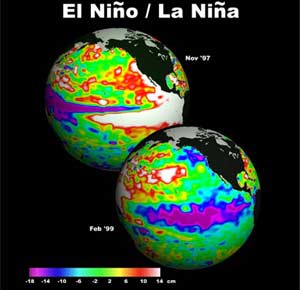After last year’s hurricane season, which featured record-breaking storms, scientists predict that this year’s hurricane season could result in more natural disasters than the long-term average, including landslides and an increased number of storms making landfall.
 |
| The two storms El Niño and La Niña (Source: nasa.gov) |
Scientists at the National University of Colorado, across the Pacific, have also issued similar warnings for the coast of the United States and the Caribbean, according to a BBC report on May 6.
According to the Vietnam Meteorological and Hydrological Institute (IMH), most statistical and dynamic models suggest that the intermediate state of the El Niño-Southern Oscillation (ENSO)—that is, between El Niño and La Niña—has returned, and forecasts indicate that these intermediate ENSO conditions in the tropical Pacific will persist until the end of 2006. The IMH also notes that the climate conditions over the next three months will be intermediate for ENSO.
This means that the number of tropical cyclones (storms and tropical depressions) occurring in the northwestern Pacific (close to or within our waters) will be approximately at the long-term average for the period from 1965 to 2005.
From now until August, alongside 3 to 4 cold air waves, the IMH predicts that about 7 to 8 tropical cyclones will occur in the northwestern Pacific, of which 4 will take place in the East Sea.
However, as in previous years, the IMH’s analysis does not mention the destructive potential of these tropical cyclones. “Extreme phenomena like these are very difficult to predict,” said Ms. Duong Lien Chau, Deputy Director of the National Center for Meteorological and Hydrological Forecasting.
Last year, the IMH did not issue any warnings about abnormal weather patterns and storms. Meanwhile, according to a report released on December 6, 2005, at the United Nations Conference on Climate Change, 2005 was assessed as the hottest, stormiest, and driest year ever recorded on the planet. The National Aeronautics and Space Administration (NASA) reported that the global average temperature in 2005 was slightly higher than in 1998.
The global economic losses due to storms in 2005 exceeded $200 billion, whereas losses from storms in 2004 were only $145 billion.
Global Warming Intensifies Storms
A scientist mentioned that he could not provide specific evidence for this year’s brutal trends, but retrospective statistics allow him to assert that the likelihood is very high. The first piece of evidence he cited was the recent occurrence of Typhoon Chanchu, which had the greatest intensity for a May storm recorded in the history of typhoons in the East Sea.
“The frequency of storm occurrences has not changed,” Ms. Duong Lien Chau said, “but it seems the energy of the storms has increased, although there are no official statistics yet.” Dr. Emanuel believes that the energy of storms has doubled in the past 30 years, and natural disasters are becoming increasingly severe.
It is not coincidental that this topic was recently discussed at the American Meteorological Society (AMS) meeting held in Monterey, California, following a study by Kerry Emanuel (a professor of atmospheric science at the Massachusetts Institute of Technology) published in the journal Nature, which pointed out the correlation between global warming and the occurrence of more powerful storms.
Professor K. Emanuel’s report indicated that measurements of sea surface temperatures from 1970 to now have increased by 0.4°C, and many of the thousands of storms during this time have also intensified.
The East Sea of Vietnam has also recorded an increase in sea temperatures and a rise in the number of strong storms out of a total of 430 storms since 1961.
In another study published in the journal Science, it was reported that over the last 150 years, sea levels have risen more than twice as fast compared to previous centuries.
Professor Emanuel established the connection between these two phenomena by demonstrating that storm energy is closely related to sea surface temperatures. “Even if we go back to the 19th century, I still see a correlation between these two parameters,” Dr. Emanuel affirmed.
According to Professor Thomas Stocker from the University of Bern, Switzerland, the current concentration of carbon dioxide (CO2) in the atmosphere is over 30% higher than previously recorded levels. Meanwhile, methane levels are over 130% higher.
Dr. Nguyen Ngoc Sinh, President of the Vietnam Nature and Environment Protection Association, stated that humans must bear some responsibility for the increasingly severe natural disasters. “The impact of humans greatly affects the natural laws,” Dr. Sinh said, “Russian Academician Verasky warned as early as the 1960s that human impacts on nature could rival geological upheavals.”
QD


















































